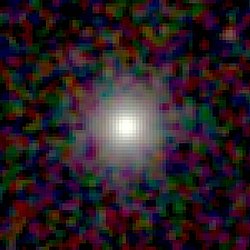The E0 NGC 79 is an elliptical galaxy estimated to be about 270 million light-years[3] away in the constellation of Andromeda. NGC 79 is its New General Catalogue designation. Its apparent magnitude is 14.9. It was discovered on 14 November 1884 by Guillaume Bigourdan.[5]

References
- ^ a b Skrutskie, Michael F.; Cutri, Roc M.; Stiening, Rae; Weinberg, Martin D.; Schneider, Stephen E.; Carpenter, John M.; Beichman, Charles A.; Capps, Richard W.; Chester, Thomas; Elias, Jonathan H.; Huchra, John P.; Liebert, James W.; Lonsdale, Carol J.; Monet, David G.; Price, Stephan; Seitzer, Patrick; Jarrett, Thomas H.; Kirkpatrick, J. Davy; Gizis, John E.; Howard, Elizabeth V.; Evans, Tracey E.; Fowler, John W.; Fullmer, Linda; Hurt, Robert L.; Light, Robert M.; Kopan, Eugene L.; Marsh, Kenneth A.; McCallon, Howard L.; Tam, Robert; Van Dyk, Schuyler D.; Wheelock, Sherry L. (1 February 2006). "The Two Micron All Sky Survey (2MASS)". The Astronomical Journal. 131 (2): 1163–1183. Bibcode:2006AJ....131.1163S. doi:10.1086/498708. ISSN 0004-6256. S2CID 18913331.
- ^ a b c "NGC 79". SIMBAD. Centre de données astronomiques de Strasbourg. Retrieved 4 February 2021.
- ^ a b Tully, R. Brent; et al. (2013). "Cosmicflows-2: The Data". The Astronomical Journal. 146 (4): 86. arXiv:1307.7213. Bibcode:2013AJ....146...86T. doi:10.1088/0004-6256/146/4/86. S2CID 118494842.
- ^ a b "Search specification: NGC 79". HyperLeda. Université Claude Bernard Lyon 1. Retrieved 4 February 2021.
- ^ Seligman, Courtney. "Celestial Atlas NGC Objects: NGC 79". Celestial Atlas. Retrieved 3 March 2015.
External links
 Media related to NGC 79 at Wikimedia Commons
Media related to NGC 79 at Wikimedia Commons









You must be logged in to post a comment.